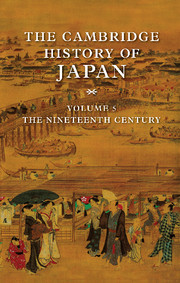Book contents
- Frontmatter
- Introduction
- 1 Japan in the early nineteenth century
- 2 The Tempō crisis
- 3 Late Tokugawa culture and thought
- 4 The foreign threat and the opening of the ports
- 5 The Meiji Restoration
- 6 Opposition movements in early Meiji, 1868–1885
- 7 Japan's turn to the west
- 8 Social change
- 9 Economic change in the nineteenth century
- 10 Meiji political institutions
- 11 Meiji conservatism
- 12 Japan's drive to great-power status
- Works Cited
- Index
- References
9 - Economic change in the nineteenth century
Published online by Cambridge University Press: 28 March 2008
- Frontmatter
- Introduction
- 1 Japan in the early nineteenth century
- 2 The Tempō crisis
- 3 Late Tokugawa culture and thought
- 4 The foreign threat and the opening of the ports
- 5 The Meiji Restoration
- 6 Opposition movements in early Meiji, 1868–1885
- 7 Japan's turn to the west
- 8 Social change
- 9 Economic change in the nineteenth century
- 10 Meiji political institutions
- 11 Meiji conservatism
- 12 Japan's drive to great-power status
- Works Cited
- Index
- References
Summary
At the beginning of the nineteenth century, Japan was a preindustrial agricultural economy with technology and living standards not greatly different from those of other preindustrial areas of Asia. If a Frenchman of 1600 had been able to see the Japan of 1800, he would have been impressed by obvious differences in dress, manners, and architecture, but most features of economic life would have been readily understandable to him. Had the same Frenchman visited Japan a century later, he would have been bewildered. By the end of the century, the nation's output of goods and services had increased fourfold, and the proportion contributed by industry had at least doubled, whereas the contribution of agriculture had declined to less than half the total output. Much of the infrastructure necessary for the development of an industrial economy, such as transport, communications, ports, and financial institutions, had been created, and a modest but crucial nucleus of modern factory industry was becoming a viable growth sector. This was a century of economic change, and the change was at an increasing rate.
Explanations for this change represent both a variety of ideologies and a variety of views of the facts. Most Japanese historians have viewed it as a transition from a feudal to a capitalist society within the framework of the Marxian theory of stages of economic development. Even granted that a relative latecomer such as Japan might be able to take advantage of some shortcuts, it was not easy to see how such a change, which took centuries in Europe, could occur within a few decades in Japan.
- Type
- Chapter
- Information
- The Cambridge History of Japan , pp. 569 - 617Publisher: Cambridge University PressPrint publication year: 1989
References
- 6
- Cited by

